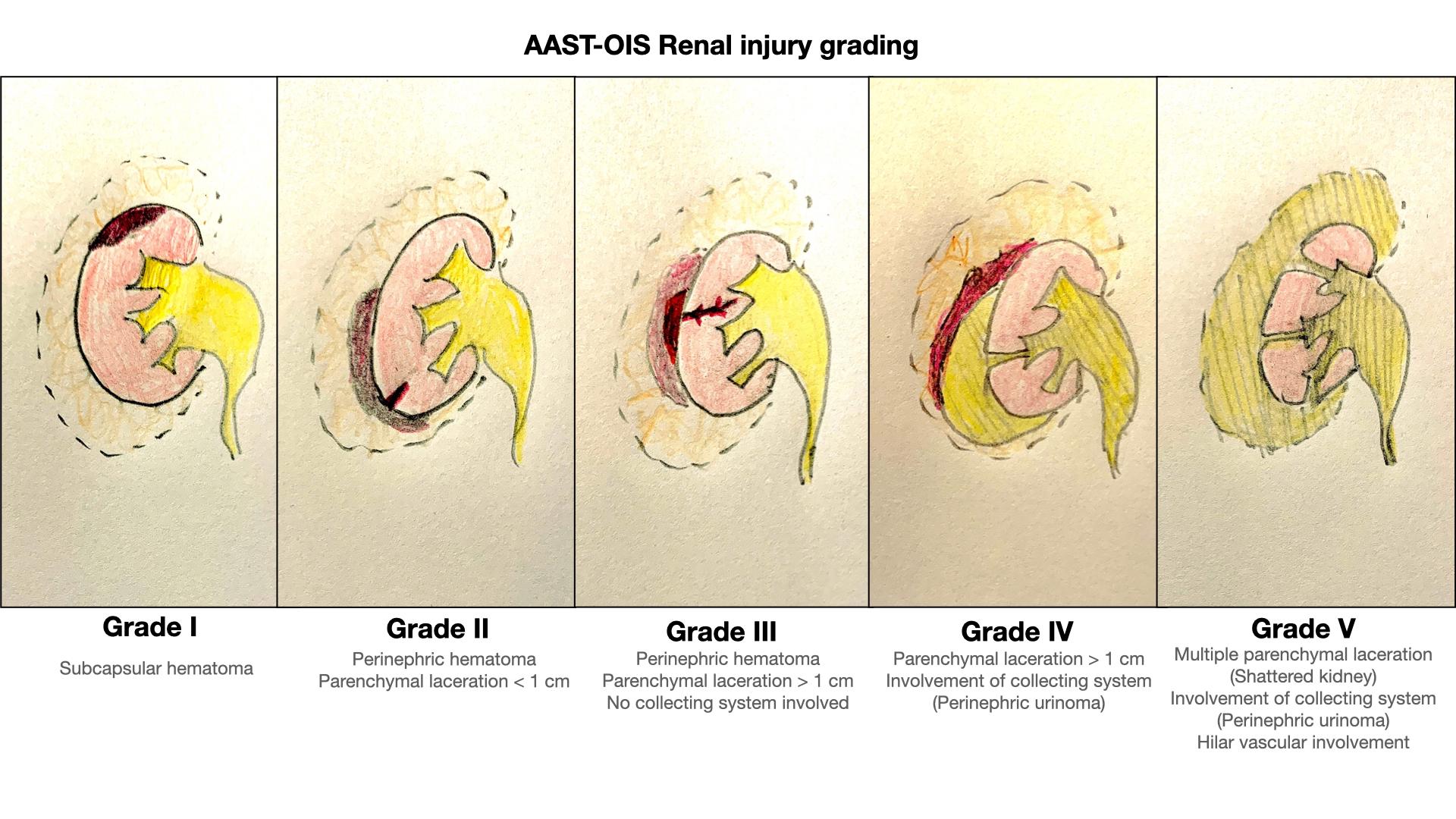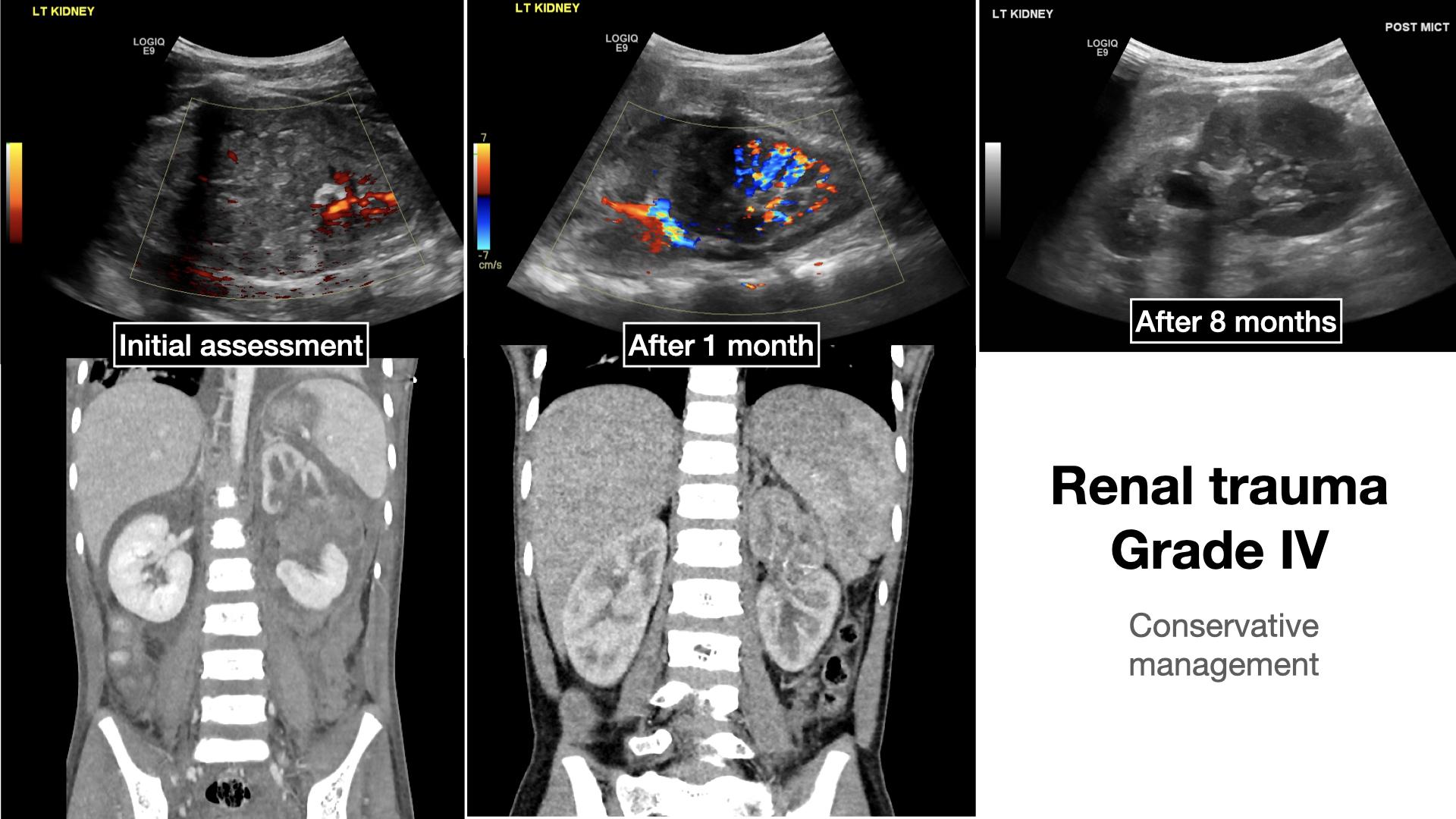52: Renal Trauma
Este capítulo durará aproximadamente 6 minutos para leer.
Introduction
Renal injury is considered one of the most common urinary tract injuries encountered in both blunt and penetrating trauma. The majority are blunt injuries, with less than 10% being penetrating. Children have a higher risk of blunt renal injuries than adults due to less supportive perinephric fat, and the thoracic ribs are more pliable, which lets the force of trauma transfer to the solid organs.
Renal trauma rarely occurs as an isolated injury and is more commonly associated with other solid organs or part of polytrauma. Renal trauma is divided into 5 grades according to its severity, with most of the injuries being of low grades.
Anatomy
It is essential to understand the anatomy of the kidney when diagnosing, grading, and to manage renal injury. Each kidney is located within the Gerota's fascia surrounding the renal space and is filled with the perirenal fat. It acts as a protecting cushion to the kidney and is less represented in children.
Composition of the renal hilum from anterior to posterior, see the renal vein as the most anterior, followed by the renal artery, and the ureter is the most posterior structure.
The right renal vein is usually shorter because of its proximity to the inferior vena cava. Both gonadal and adrenal veins drain directly to the inferior vena cava on the right side. In contrast, on the left, the renal vein is usually longer and receives both gonadal and adrenal veins from the left side.
Each renal artery comes directly from the aorta, divided into five branches: apical, superior, middle, lower, and posterior. Occasionally, accessory branches come directly from the aorta.
Signs suggestive of renal trauma:
- Hematuria
- Flank ecchymosis
- Penetrating injury in the region
- Fractured ribs (especially lower ribs)
- Abdominal mass
- Abdominal tenderness
The concept of “significant hematuria” after trauma is debated in children.1 While some authors consider a cutoff of >5 RBC/HPF; others advocate for >50 RBC/HPF. Hematuria alone, however, is not a reliable marker of renal injury. Moreover, the degree of** hematuria does not correlate with the degree of injury**.
With this in mind, others recommend investigating any hematuria (microscopic or gross) in any child with blunt abdominal trauma associated with a decelerating mechanism (MVC, pedestrian strike, fall from height).1
Diagnostic Studies
Upon suspicion of renal injury, the ultrasound is the initial tool for management. As stated before, many renal injuries occur in the context of blunt abdominal trauma for whom current protocols include initial imaging as FAST ultrasound scan ,2,3 This ultrasound will give the initial picture that the kidney is possibly being affected by the traumatic event.
Once the renal trauma is diagnosed, more specific investigations must be performed to evaluate the extent of the involvement of the kidney. Among the armamentarium for the physician, the following can help to determine this.
- US (Ultrasound): the US with Doppler can be used for those with very mild trauma and lower suspicion for significant injury but cannot distinguish extravasated urine from blood and cannot accurately image the vascular pedicle.
- IVP (Intravenous Pyelogram) was widely used in the past and is used nowadays when no Computer Tomography is available. It can be performed either in the trauma room or in the operating theatre. An intravenous contrast of 2 mL/kg is administered, and an x-ray will be taken after 10 minutes. It is helpful to diagnose the functionality of the kidneys and the presence of any extravasation.
-
CT with IV contrast is the current gold standard: It is valid to evaluate the anatomy and functionality of the kidneys and the renovascular system in a time-efficient manner.
- Ideally, a "four-phase" CT with IV contrast images the arterial, nephrographic, and pyelographic phases; however, this is rarely done because of the increased radiation associated with four passes.
- Standard CT imaging obtains arterial phase and early cortical phase… which may miss some parenchymal or collecting system injuries.1
- CT findings alone do NOT determine management.4
- Angiography or intraoperative IV urography are also tools to image in some instances.
Grading
The American Association for the Surgery of Trauma Organ Injury Scale (AAST-OIS) is the most common grading system used for solid organ injuries, including the kidney.5 The grading system is based on the CT scan and operative findings. This grading system is adapted from adults and is still used for pediatric trauma. It is divided into 5 grades: grades 1-2 are considered low grades, while 4-5 are high grades.
- Grade I – Contusion or non-expanding subcapsular hematoma
- Grade II – Perinephric hematoma with parenchymal laceration < 1cm deep
- Grade III – As Grade II with laceration >1cm in depth. No collecting system is involved.
- Grade IV – Laceration involving collecting system (perinephric urinoma)
- Grade V – Parenchymal laceration involving collecting system (shattered kidney) and/or main renal vein/artery laceration or avulsion of the main artery or thrombosis of the renal vein.

Figure 1 AAST-OIS renal trauma grading system.
Possible Complications
- Urinary extravasation (most common complication, particularly with grades IV and V)
- Urinoma
- It may present acutely or weeks-months later
- The usual signs are pain, fever, ileus and a palpable mass
- Secondary hemorrhage
- Delayed bleeding, which occurs in 13–25% of Grade III–V injuries
- Usually seen in the first 2–3 weeks after trauma
- Perinephric abscess (rare)
- AV fistula formation (rare and exclusively from stab wounds)
- Pseudoaneurysm
- Calyceal diverticula
- Impaired renal function
- Hypertension
Management
The first determinant for the management is the hemodynamic status. The stable patients can proceed to complete investigations for possible conservative (non-operative) management. Hemodynamically unstable patients not responsive to fluid resuscitation should undergo urgent operative management.
In an alert and communicative child with minimal symptoms and no concerning physical findings which have <50 RBC/HPF, observation or screening U/S with Doppler rather than obtaining a CT simply for evaluation of kidneys may be reasonable.1
Once the kidney damage secondary to the trauma is diagnosed, it is recommended to establish complete urine drainage at low pressures. A simple transurethral catheter in the bladder as an initial measure only is the simplest and most effective (and sometimes the only needed).
Overall, renal trauma in children is managed conservatively, even with higher-grade injuries.1,4,6 Specifically, all Grade I–III injuries can be managed non-operatively.7 There is evidence that Grade IV and V can be managed conservatively, too.4 These higher-grade injuries require a careful, tailored approach to each individual.1 This is particularly relevant in pediatric patients where Grade IV injuries are a heterogeneous population.3

Figure 2 Example patient with Grade IV renal trauma at initial presentation, after 1 month, and after 8 months.
One must always keep in mind that The American Association for the Surgery of Trauma grading system is not perfect and leads to controversies.6 The reason is that this grading system is based predominantly on the adult population and may not adequately reflect the pediatric population.6 Some further subdivide Grade IV for this reason.
Surgery is recommended for:1
- Hemodynamically UNSTABLE patients
- Those with severe intra-abdominal PENETRATING injuries.
Surgery or interventional radiology may be required for:1
- Massive urinary extravasation in Grades IV–V
- Extensive (>20%) nonviable tissue
- Arterial injury
- Incomplete staging
Whatever the initial grading, if observation management is established, continued patient monitoring is recommended to assess whether it can present delayed damage to the kidney. Any change in vital signs and/or new onset of hematuria should be promptly reassessed by imaging.
Key Points
- Do not overlook the hematuria! Not everyone needs a CT scan, in any case!
- Know the limitations of your imaging! You cannot see what you do not image
- Unless hemodynamically unstable, usually all traumas can be managed non-operatively
- Assess and reassess your patient, clinical picture can be changed
References
- Fernández-Ibieta M. Renal Trauma in Pediatrics: A Current Review. Urology 2018. DOI: 10.1016/j.urology.2017.09.030.
- Ollerton JE, Sugrue M, Balogh Z, D’Amours SK, Giles A, Wyllie P. Focused Assessment with Sonography in Trauma. J Trauma 2006; 60 (4): 785–791. DOI: 10.1017/cbo9780511544811.052.
- Root JM, Abo A. Cohen J. Point-of-Care Ultrasound Evaluation of Severe Renal Trauma in an Adolescent. Pediatr Emerg Care 2018; 34: 286–287. DOI: 10.1097/pec.0000000000001406.
- LeeVan E, Zmora O, Cazzulino F, Burke RV, Zagory J, Upperman JS. Management of pediatric blunt renal trauma: A systematic review. J Trauma Acute Care Surg 2016. DOI: 10.1097/ta.0000000000000950.
- Ballon-Landa E, Raheem OA, Fuller TW, Kobayashi L, Buckley JC. Renal Trauma Classification and Management: Validating the Revised Renal Injury Grading Scale. J Urol 2019; 202 (5): 994–1000. DOI: 10.1097/ju.0000000000000358.
- Murphy GP, Gaither TW, Awad MA, Osterberg EC, Baradaran N, Copp HL, et al.. Management of Pediatric Grade IV Renal Trauma. Curr Urol Rep 2017; 18: 23. DOI: 10.1007/s11934-017-0665-z.
- Bartley JM, Santucci RA. Computed tomography findings in patients with pediatric blunt renal trauma in whom expectant (nonoperative) management failed. Urology 2012; 80 (6): 1338–1343. DOI: 10.1016/j.urology.2012.07.077.
Última actualización: 2024-03-17 22:36